Do you have a question about the Sea Ray 52 Sundancer and is the answer not in the manual?
Welcome message and overview of the Owner's Manual Packet contents for new boat owners.
Details the purpose and content of the owner's manual, including safety and operation information.
Details the operator's responsibilities for safe boating, including courses and rules.
Explains the significance of the Hull Identification Number for correspondence and identification.
Discusses Sea Ray's compliance with safety acts and association certifications like NMMA and ABYC.
Provides information on locating authorized dealers for service, parts, and repairs.
Lists important phone numbers and internet addresses for Sea Ray, USCG, and BoatUS.
Details the terms and coverage of the Sea Ray express limited warranty, including exclusions.
Explains the meaning of different safety labels (DANGER, WARNING, CAUTION, NOTICE) found on the boat.
Lists legally required safety equipment for boats, including PFDs and fire extinguishers.
Details the automatic fire extinguisher system and procedures during a fire event.
Discusses carbon monoxide poisoning symptoms, causes, and prevention methods on board.
Explains the importance of PFDs and classifies different types (I, II, III, IV, V).
Lists additional recommended equipment for safe boating operation, especially when out of sight of land.
Warns against operating the boat under the influence of drugs or alcohol due to impaired judgment.
Advises on proper load capacity and passenger seating for safety in various conditions.
Stresses not exceeding maximum engine power rating and advises on propeller selection.
Discusses factors affecting boat stability, including passenger and gear distribution.
Emphasizes operator's constant awareness of surroundings and conditions for safe control.
Details boat design categories and safety procedures for various weather conditions and storms.
Explains the importance of charting a course and using navigational aids to avoid hazards.
Provides safety guidelines for water sports like swimming, emphasizing engine shutoff and awareness.
Covers procedures for medical emergencies and water rescue, including making contact and returning to the boat.
Details procedures for fighting boat fires, including using extinguishers and abandoning ship.
Outlines steps for handling flooding, swamping, capsizing, collisions, and leaks.
Provides guidance for grounding, propulsion, control, or steering failures, and safety hotlines.
Provides a glossary of nautical terms used throughout the manual for better understanding.
Addresses regulations and practices for fuel/oil spills and waste disposal to protect the environment.
Explains the meaning of various symbols found on controls and prints for user reference.
Illustrates the locations of various warning labels on the boat for safety awareness.
Provides guidance on proper procedures for docking, lifting, and storing the boat safely.
Details safe passenger locations on the boat and warnings about wet decks and boat motion.
Lists essential boat dimensions, clearances, and specifications for reference.
Illustrates the layout of the upper deck, identifying key components and features.
Provides a diagram of the interior layout, showing the location of cabins, amenities, and systems.
Details the arrangement of gauges, controls, and switches at the helm station for operation.
Provides a continued view of the control station layout, including optional equipment and electronics.
Explains the function and layout of the standard control station switch panel for operating various boat systems.
Illustrates the location and function of various through-hull cutouts for different systems.
Describes the standard inboard V-drive propulsion system and engine information.
Explains the operation of gear shift and throttle controls, including start-in-gear protection.
Details how to use the engine synchronizer feature for electronic speed control of both engines.
Explains the operation and adjustment of the hydraulic trim tab system for hull attitude control.
Describes the function of important gauges like tachometer, oil pressure, and fuel level.
Introduces the SmartCraft System View display for comprehensive boat information and monitoring.
Explains the Systems Monitor, its components (DCM, BIM), and functions for critical alerts.
Provides guidance on magnetic compass adjustment, reading, and maintenance for navigation.
Details the operation of navigation and anchor lights, including when they must be used.
Provides a comprehensive checklist for preparing the boat and crew before departing for a trip.
Outlines procedures and safety precautions for operating the boat while underway.
Details the steps for safely returning the boat to port, including passenger and boat system checks.
Provides a checklist for properly securing the boat after use, including shore power and systems.
Details safe fueling procedures, including general precautions, tank filling, and post-fueling checks.
Covers instructions for passengers regarding boat behavior and safety during operation.
Provides essential reminders for safely starting the boat's engines, emphasizing pre-start checks.
Explains the function of various engine operation switches like Engine Sync and Cruise Control.
Details how to shift gears and use throttle controls, including warnings for proper operation.
Provides instructions for safely stopping the boat's engines, including cool-down procedures.
Explains the hydraulic power steering system, its components, and fluid recommendations.
Outlines the procedure for safely starting the generator, including pre-start checks and operation.
Details the process of switching between shore power and generator power for AC systems.
Provides instructions for safely stopping the generator, including cool-down and breaker procedures.
Explains the Cablemaster system for automatic retrieval and deployment of the shore power cord.
Introduces anchoring procedures, including bringing the bow into the wind and lowering the anchor.
Explains the concepts of rode and scope and their importance for effective anchor performance.
Details procedures for lowering, setting, weighing, and clearing a fouled anchor.
Describes how to operate the windlass from the helm or bow, including manual operation and maintenance.
Addresses regulations and practices for preventing fuel and oil spills in the bilge area.
Details the bilge pump system, including automatic and manual operation, and float switches.
Explains the function of bilge blowers for ventilation and odor removal, including operation and troubleshooting.
Emphasizes the importance of engine maintenance and familiarity with the Engine Operator's Manual.
Describes the engine gauge package as a safety feature and how to interpret gauge readings.
Explains the adjustable engine mounts and the importance of proper tightening for alignment.
Details the function of reduction and reverse gears, including operational warnings and maintenance.
Describes the engine exhaust system, water flow, and the importance of ensuring tightness of fittings.
Provides a generalized procedure for engine removal, recommending dealer assistance.
Discusses common causes of engine vibration and advises immediate dealer contact if severe.
Explains the fresh water cooling system and the recommendation for annual coolant changes.
Details propeller care, replacement, and the phenomenon of ventilation and its correction.
Explains shaft coupling, alignment procedures, and the importance of proper tolerances.
Describes the rudder and stuffing box function, emphasizing leak checks and proper adjustment.
Provides instructions for opening/closing seacocks and cleaning strainers for cooling systems.
Explains the hydraulic power steering system, its components, and fluid recommendations.
Provides a detailed diagram of the engine room layout with labeled components.
Covers fuel system checks, lines, filters, and tank shut-off valves for safe operation.
Details fuel tank capacity, location of fill inlets, and the function of fuel tank vents.
Emphasizes fuel quality, contamination prevention, and keeping tanks full for optimal performance.
Explains the generator crossover fuel system for drawing fuel from different tanks.
Describes primary and secondary fuel filters, their location, and the benefit of dual filter systems.
Details procedures for draining water from fuel filters and replacing filter elements for optimal efficiency.
Provides critical precautions for safe fueling, including checklists before, during, and after refueling.
Explains the 12-volt DC electrical system, power sources, and grounding.
Details battery selection, safety precautions in storage areas, and cable removal procedures.
Explains the function of main battery switches and solenoids for controlling 12-volt DC systems.
Covers ignition protection in the engine room and essential battery maintenance practices.
Advises on selecting the correct amperage for fuses and breakers and the hazards of incorrect ratings.
Describes the use of automotive type blade fuses for overload protection in fuse blocks.
Identifies the location of the main DC breaker panel in the engine room and its function.
Illustrates the component board in the engine room, showing location of systems monitor and breakers.
Shows the main DC distribution panel and box located on the engine room forward bulkhead.
Details the DC main solenoid panel, including battery solenoids, fuse holders, and modules.
Explains how to locate and reset tripped breakers on the control station breaker panel.
Describes the controls and functions of the 12-volt DC distribution panel located in the salon cabin.
Details the location and use of 12-volt accessory receptacles for powering devices.
Explains the emergency start system for paralleling batteries to assist engine starting.
Covers the electronics circuit, its breaker location, and powering the fuse block at the control station.
Describes the Xelogen lighting system, its power source, and safety precautions for heat.
Explains how the overhead Xelogen lighting is powered by AC through transformers.
Advises on replacing bulbs using the correct type and wattage for various lighting fixtures.
Illustrates the locations of exterior lighting fixtures, including navigation and storage lights.
Shows the layout of interior lighting fixtures, including round, swivel, and step lights.
Diagrams the layout of switches and receptacles throughout the boat for easy identification.
Details the 52 DA's AC electrical system, power sources, and critical safety warnings.
Provides crucial safety warnings regarding shore power connections and swimming near operating AC systems.
Explains the benefits of isolation transformers for eliminating shock hazards and preventing reverse polarity.
Describes the IsoBoost Transformer's ability to automatically adjust voltage for consistent AC power.
Details the Glendenning Cablemaster system for remote control of shore power cord management.
Identifies the main shore power breaker box location and its role in operating the AC shore power system.
Guides users on connecting to U.S. standard shore power, emphasizing understanding power distribution.
Explains shore power hookup for international (220/50V) service, including LINE 1 and LINE 2 connections.
Instructs on using the source selector to switch between generator and shore power, emphasizing safety.
Provides guidance on maintaining shore power cables and inlets to prevent corrosion and ensure safety.
Recommends referring servicing of the main distribution panel to a qualified electrician.
Details the controls and functions of the AC main distribution panel for managing onboard AC power.
Describes the automatic battery charging unit, its features, and charging stages (Bulk, Absorption, Float).
Explains the function and location of GFI receptacles for protection against shock hazards.
Describes the Residual Current Circuit Breaker (RCCB) protecting international outlets.
Covers generator operation, warranty, diagnostics, and safety precautions for enclosed areas.
Explains electrolysis, galvanic action, and the importance of checking and replacing zinc anodes.
Introduces the electrical schematics and wiring harness diagrams, recommending professional service.
Presents the first part of the DC wiring schematics, detailing system connections and components.
Illustrates the engine harness schematic for Cummins QSM-II engines with SmartCraft integration.
Provides the wiring schematic for optional MAN engines, detailing harness connections.
Shows the wiring diagrams for the Rexroth control system, likely for throttle or steering.
Details the wiring schematic for the Cable Master remote control system for shore power cords.
Presents the schematic for the Systems Monitor, illustrating its connections and functions.
Provides the wiring schematic for the Lofrans Progress 2 windlass system, including controls and power.
Illustrates the wiring schematic for the boat's stereo system, showing component connections.
Details the wiring diagram for the Bose® audio system, including speaker and subwoofer connections.
Shows the coaxial cable connections for the TV and stereo systems, including antenna and splitter.
Illustrates the wiring for the satellite TV option, including receiver, modulator, and antenna connections.
Describes the DSS Digital Audio Modulator and its connections for audio/video signals.
Provides the wiring schematic for the bow thruster system, detailing its power and control connections.
Details the wiring schematic for the Onan Diesel generator, including start, stop, and monitoring circuits.
Illustrates the high voltage wiring diagram for the generator, showing connections to the main distribution panel.
Shows the wiring schematic for the optional hydraulic swim platform, including remote control and solenoids.
Presents the AC wiring schematic for the 240-volt system, detailing power distribution and circuits.
Illustrates the AC wiring schematic for the 220/50 volt system, covering power distribution and components.
Details the components and wiring diagram for European GFCI (RCD) protected receptacles.
Shows the AC system wiring diagram for the international option, covering 240/120V circuits.
Illustrates the SmartCraft system diagram for Cummins QSM-II engines, detailing data connections.
Shows the interconnect diagram for the Sea Ray Navigator, including GPS, data, and power connections.
Presents a high-level interconnect diagram showing major system connections between components.
Details the interconnect diagram for the VHF radio system, including base station and external speaker.
Illustrates the wiring installation for bilge pumps, blowers, and related components.
Shows the installation diagram for the cabin wiring harness, detailing component connections.
Continues the illustration of the cabin harness installation, showing further component routing and connections.
Completes the cabin harness installation diagrams, showing remaining component connections.
Illustrates the installation diagram for the guest head wiring harness.
Shows the installation diagram for the port cockpit wiring harness, detailing connections.
Details the installation diagram for the starboard cockpit wiring harness, including component locations.
Diagrams the layout of lighting, switches, and receptacles within the boat's interior and exterior.
Suggests reviewing layout diagrams and familiarizing oneself with yacht features for operation and maintenance.
Explains the function, testing, and critical safety warnings associated with the carbon monoxide monitors.
Describes the air conditioning/heating system, its components, locations, and cooling mechanism.
Provides steps to start the air conditioning system, including checking seacocks and turning on breakers.
Details the fresh water system components, activation, and sanitization procedures.
Provides information on the water tank capacity, level checking, and safe filling procedures.
Illustrates the routing of water lines for the aft section of the boat, including showers and faucets.
Shows the routing of water lines for the forward section of the boat, including heads and sinks.
Refers to winterization procedures for the water system, emphasizing protection against freezing.
Explains the water distribution manifold's role in directing water to various equipment and isolating leaks.
Details the maintenance of the water pump and its pre-filter and post-filter components for optimal performance.
Covers the operation and maintenance of the water heater, including initial startup and freeze prevention.
Describes the shower sump system, its automatic pump, and float switch operation.
Explains the fresh water washdown system, including spigot locations and pump operation.
Details how to connect to a dockside water source for the boat's fresh water system.
Provides instructions for operating the cockpit shower, including hot water and pump activation.
Advises on controlling water valves for the washer/dryer unit, emphasizing shutoff when not in use.
Introduces the head system, holding tank, macerator, and discharge options, stressing careful reading.
Explains the operation of the Vacu-Flush head, including breaker controls and flushing procedures.
Details holding tank operation, fluid level indicators, and the importance of timely emptying.
Illustrates the Vacu-Flush head system with holding tank and optional macerator, showing component layout.
Explains the vent filter's purpose and the need for periodic replacement to control odors.
Describes the optional macerator discharge pump system, its interlock switch, and operating procedures.
Introduces entertainment center options, suggesting referral to individual equipment manuals.
Explains the TV signal selector panel and procedures for connecting dockside television reception.
Describes the salon entertainment center components, including TV, sound system, and speaker setup.
Details entertainment systems in the forward and guest staterooms, including TV/DVD units and power requirements.
Explains the standard cockpit stereo system, its remote control, speakers, and power source.
Describes the optional digital satellite system, its power switch, and data port for diagnostics.
Lists the standard and optional features of the cockpit wet bar, including sink, faucet, and refrigerator.
Provides instructions for connecting the dockside telephone hookup to the boat's inlet.
Details the automatic fire extinguisher system, its indicator light, and engine shutdown override.
Explains how to manually activate the automatic extinguisher and the benefits of early detection.
Locates the four hand-held fire extinguishers and advises on checking and recharging them.
Provides instructions for operating the optional hydraulic swim platform using the remote control, with safety warnings.
Details the operation of galley refrigerator/freezer units and cockpit refrigerator/ice maker.
Explains the power ventilation system that removes stagnant air using exhaust fans.
Describes the central vacuum system, its hose connections, and how to activate the vacuum.
Covers the operation of the electric stove and microwave/convection oven, including power requirements.
Provides instructions for caring for and maintaining the boat's canvas, including cleaning and storage.
Details tips for installing canvas pieces and proper methods for storing canvas and clear vinyl.
Covers cleaning recommendations for exterior and interior upholstery fabrics, including mildew prevention.
Introduces the Sea Ray Navigator, an onboard computer navigation aid, and its features.
Provides a template for recording owner, boat, and engine details for service and warranty purposes.
Outlines the recommended maintenance schedule for engines, generators, and various boat systems.
Continues the maintenance schedule, covering exhaust, fuel, steering, and electrical systems.
Provides instructions for draining the boat and its systems, and a checklist for winterization on land.
Details winterization steps for engines, generators, air conditioners, and other boat systems.
Covers winterizing procedures for the head, water, and fuel systems, including antifreeze usage.
Advises on boat security measures and proper storage procedures for batteries.
Lists essential checks for fuel, exhaust, batteries, and other systems after the boat has been stored.
Covers seacock lubrication and miscellaneous checks like thru-hull fittings, rudder, and lights.
Provides a quick checklist for boarding the boat, covering general, boat systems, and engine checks.
Details the pre-departure and engine starting checklist, emphasizing safety and proper procedures.
Covers checklist items for safe operation while underway, including passenger, trim tabs, and navigation lights.
Provides a checklist for procedures when returning to port, including securing the boat and checking bilges.
Covers engine securing procedures and troubleshooting steps if the engine fails to start.
Details the checklist for starting and stopping the generator, including loading and safety warnings.
Provides a checklist for verifying the seaworthiness and proper operation of added aftermarket equipment.
Offers a template for logging all maintenance performed on the boat, including dates and engine hours.
Recommends using specific products for maintaining the factory-new appearance of the boat's fiberglass.
Warns against using hazardous cleaning agents and advises consulting dealers for environmental regulations.
Explains fiberglass and gelcoat properties and recommends regular washing and waxing for luster.
Provides methods for preventing marine growth on moored boats, including scrubbing and antifouling paint.
Offers advice on removing stains and scratches from surfaces, warning against abrasive cleaners.
Details cleaning procedures for the bilge and engine compartment, including checking wiring and fuel systems.
Covers cleaning stainless steel fittings and removing salt crystals from instruments and plastic covers.
Recommends simple wiping for gauge and switch panels, with no special chemicals required.
Provides instructions for cleaning acrylic plastic, warning against dry cloths and certain solvents.
Advises on proper storage methods for canvas and clear vinyl pieces to prevent damage and mildew.
Covers cleaning recommendations for exterior and interior upholstery fabrics, including mildew prevention.
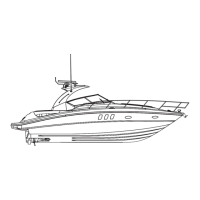
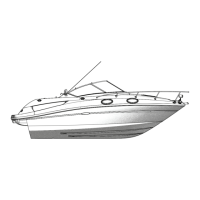
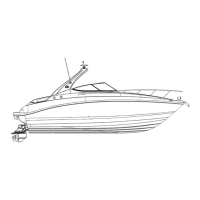
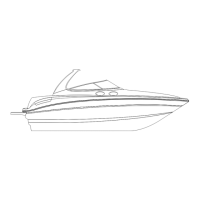
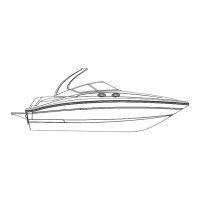
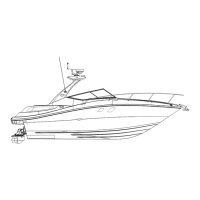
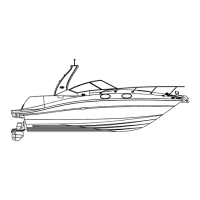
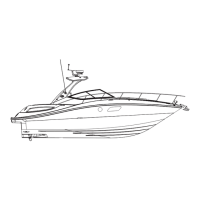
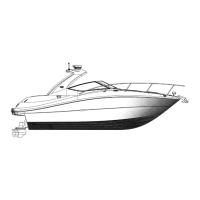
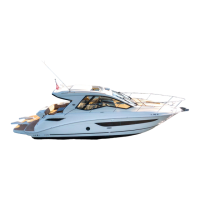
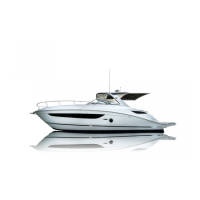
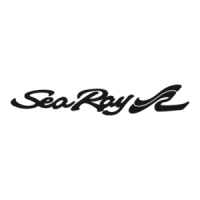
